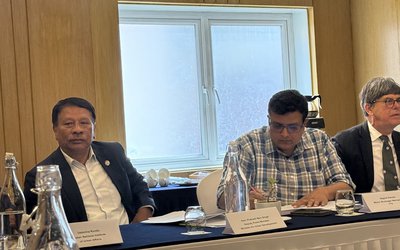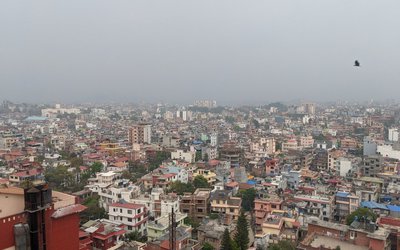Nepalis have been going to different parts of the world. Our Princess Bhrikuti went to Tibet as a bride and propagated the Buddhist religion there. Arniko, then went to Tibet and then China as a builder and introduced the pagoda style of architecture in Beijing. Later our people joinedas mercenary fighters to the army of Maharaja Ranjit Singh at Lahore and so were referred to as lahures. They alsofought the British and drove them back to finally end up signing the Treaty of Sugauli in 1816. Jang Bahadur’s troops marched to Lucknow in aid of the British at the time of the Indian Mutiny of 1857.
The British, although they praised the valour of the Gurkhas and recruited them into their Colonial Army in India never really considered taking over Nepal. Nepal being landlocked and mountainous,it would have meant great expenditure without reasonable returns. Their attention was attracted to the recruitment of trust-worthy hardy men to the hills to fight for them. The Gurkha soldier of Nepal went to the Middle East and South-East Asia fighting for British causes. In the course of these wars for the British the Gurkhas won many Victoria Crosses, the top medals for valour. After the wars, some Nepalisstayed on and settledin lands where they had gone as soldiers to fightor to maintain peace. Some Nepalis, hiding their identity went to Fiji and elsewhere as labourers and their descendants are there today.
Following the independence of India the Gurkha Battalions were also divided. Some went to UK to guard the Tower of London with its antiquities like the Kohinoor diamond and others were deputed to guard the Queen’s Buckingham Palace. Those,whose playing fields was India, went to oversee the line of control between India and Pakistan or even to fight at Kargil. The recruitment of our nationals as Gurkha soldiers goes on as usual for both the British and Indian armies.
Besides the Gurkhas the other Nepalis to gain name and fame in the world setting are the Sherpas who have got their names in the Guinness’s Book of Records for various ‘firsts’ in the field of mountaineering.
Nepalis, because of the Hindu culture and lifestylefeel quite at home in India. Their concentrationsin the East is at Darjeeling and at Dehra Dun in the West. The latest ‘grapevine’ news circulating in Kathmandu is that the Nepali speaking population of Sikkim is ecstatic to be in the Union of Indian States! After all it is the only state in India where Nepali is the official language.
Nepalis too are now following in the footsteps of our neighbours in the North and South. They are going all over and the largest number of Nepalis outside of India and countries of the Middle East is probably USA. Here however their number has increased because of the Bhutanese of Nepali origins who have been driven out of Bhutan to be resettled in the States. Though many, who are elderly have felt out of place, the majority arelikely to join the Nepali diaspora as a result of circumstance rather than bychoice. Migration of people to different culturalareas if they stay aloof too long,tends to create ghettos of variedcultures in different lands. Howeverbecause we speak similar language and are of similar culture it is not surprising that Nepalis also congregate where the Indians are as at Jackson Heights in Washington. As Nepalis visit, work and live in different lands many have started documenting their experiences and thoughts on paper or even the Internet. This trend is increasing and will thus help tremendously to disseminate and fortify our Nepali culture for future generations. This is something that will lead to greater things in the future.
As I started using a social networking programme such as Facebook,Google and Yahoo I came across various groups of people who are very conscientiously putting forward their views on various topicsfor improving conditionsand trying to motivate people in Nepal to come out on to the streets in support of various causes. We have seen the results and the upheavals that have occurred in many countries of the Middle East. This is all good if it results in benefit at large to the people. As I surfed the Internet and read what has been written by various groups of Nepalis I sometimes had the feeling that many had their individual axes to grind and ideas to disperse – some political, some religious etc. . Perhaps some were doing this because of boredom and a yearning to be back in familiar surroundings. A recent development is that some children of Nepali origin who have been educated in the States, UK, Australia and Canada are being sent back to the country of their parents to do their graduate studies. This is a good trend which needs to increase further for it will benefit both parties.
Political uncertainty prevails all over Nepal. One hears leaders tell us that what is happening in Nepal is as per the wish of what certain external powers. There is no doubt that our leaders have disappointed many and so this may be a ‘red herring’ let loose by them, to divert attention from their incompetence. No direct charges are made but the innuendoes are there. The other rumour doing the rounds is that foreign funded NGOs or INGOs, with unlimited funds are literally in the process of creating discord amongst the different communities. Has that process occurred already and are we being controlled as puppets on a string? If it has, are we headed towards Doomsday as the world watches?

Hemang Dixit
The author writes fiction under the name of Mani Dixit. Website: www.hdixit.org.np. Twitter: @manidixithd
- Top Heavy
- Sep 20, 2023
- Most Able?
- Sep 04, 2023
- Changing Times
- Aug 21, 2023
- Nepali Shenanigans
- Aug 03, 2023
- Budget Naataks
- Jun 29, 2023














